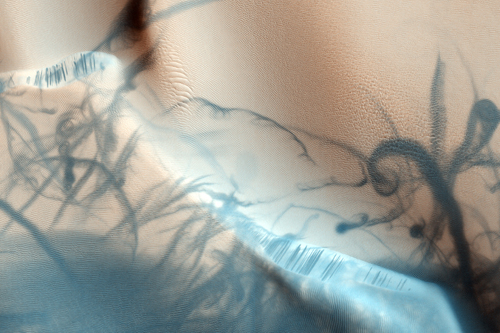
Got this pic from HiRISE.
Take this as a psychological picture test. You know, those kind of test where the psychologist flips a card with a blot of ink on it and ask you tell him/her what cross your mind in the first spontaneous minute.
Usually, if you're answer is butterfly, then you'll be assessed as someone who is innocent or happy or both. If you saw a devil in it, you'll probably just born to be wild or evil or perhaps, both.
Anyway, just take a look at the picture above.
What is your first impression? And yeah, no, this is not a psyche test, so please don't scroll down or look back and front for the psyche interpretation.
For a minute, it looks like a great artwork. Some abstract kind of beautiful art.
Then if you look closer, maybe it is body art, with the skin like texture over the right side and the ?buttcrease or ?cleavage over the upper left.
Honestly it is an artwork. An artwork of nature.
But not on our planet.
In the neighbouring Mars
Those aura-like blue rays are actually caused by dust devils.
Take this as a psychological picture test. You know, those kind of test where the psychologist flips a card with a blot of ink on it and ask you tell him/her what cross your mind in the first spontaneous minute.
Usually, if you're answer is butterfly, then you'll be assessed as someone who is innocent or happy or both. If you saw a devil in it, you'll probably just born to be wild or evil or perhaps, both.
Anyway, just take a look at the picture above.
What is your first impression? And yeah, no, this is not a psyche test, so please don't scroll down or look back and front for the psyche interpretation.
For a minute, it looks like a great artwork. Some abstract kind of beautiful art.
Then if you look closer, maybe it is body art, with the skin like texture over the right side and the ?buttcrease or ?cleavage over the upper left.
Honestly it is an artwork. An artwork of nature.
But not on our planet.
In the neighbouring Mars
Those aura-like blue rays are actually caused by dust devils.
A Martian dust devil spins across Gusev Crater just before noon on March 15, 2005. Photo credit: Mars rover Spirit.
Thanks to Phil Plait & Dr. McEwen, here's the down-to-earth overview explanation of the making of the artwork.


2 comments:
Seriously, I thought of Mars when I saw the title - had just watched an "educational" programme on the History Channel! But when I scrutinized the image an Ascaris came to mind, surrounded by overlapping haustrations. Yeah, how nerdy LOL
ascaris... very academic... nerdy.. no..
Post a Comment